30 October 2023
![]() 6 mins Read
6 mins Read
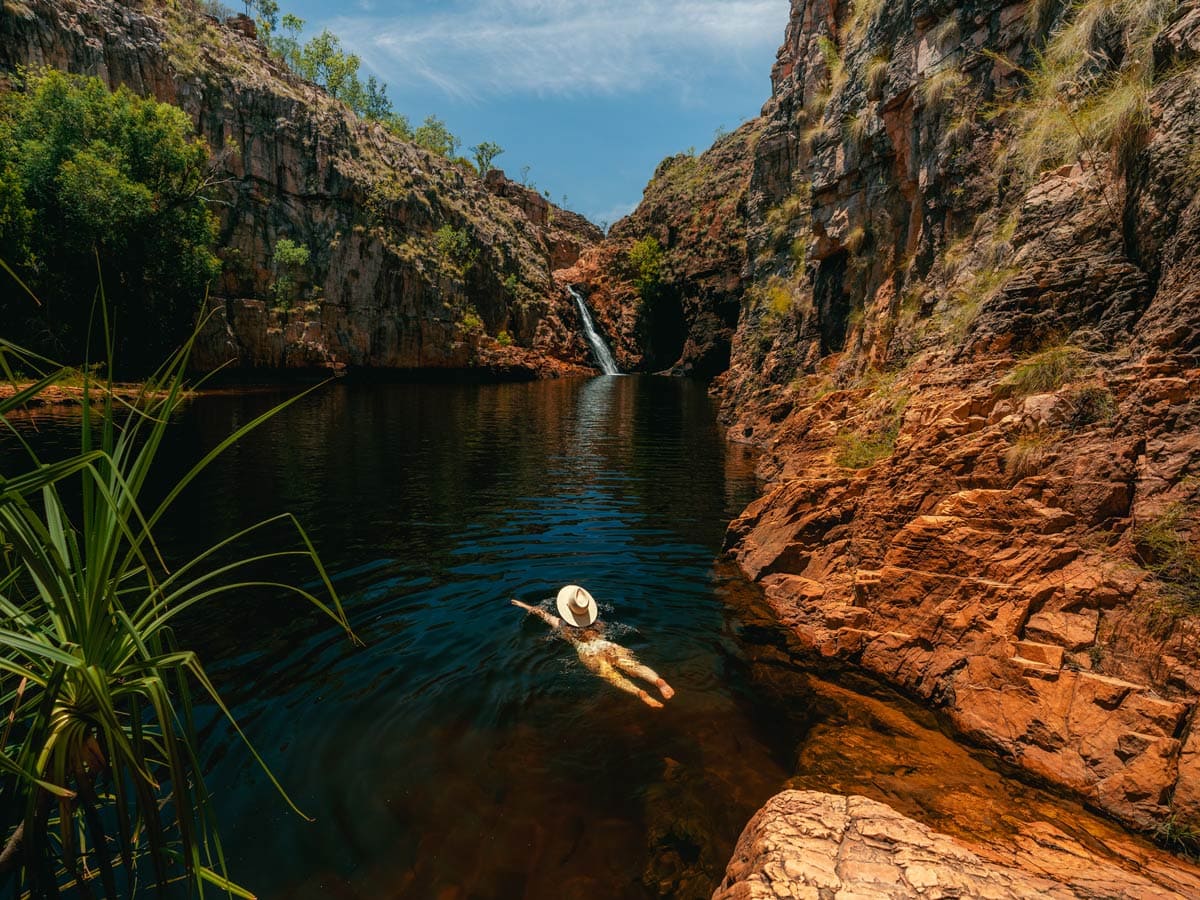
Kakadu National Park is the jewel of the Northern Territory’s Top End. Its awe-inspiring landscapes and rich living culture attract visitors from across Australia and the world. The region is a UNESCO World Heritage-listed site, dual-listed for both its outstanding nature and culture. The Traditional Owners of Kakadu National Park are the Bininj in the north and the Mungguy in the south. It’s important to respect the culture, so it’s a good idea to familiarise yourself with local culture and customs before you arrive.
It’s also worth noting that to enter Kakadu National Park, visitors must purchase a Parks Pass that can be purchased online or at one of the visitor centres listed on the Parks website. Passes are free for Northern Territory residents. Here’s everything else you need to know about planning a trip to Kakadu National Park.
Located within a protected area of the Northern Territory, Kakadu National Park can be found 253 kilometres from Darwin. It takes about 2.5 hours to drive between Darwin to Kakadu. The park is located within the Alligator Rivers Region.

Nawurlandja Lookout overlooks Nourlangie Rock and the Arnhem Land escarpment. (Image: Tourism NT/@jack.and.megan)
The best time to visit Kakadu National Park depends on what you want to see, experience and do there.
The countryside changes with the seasons – during the monsoon or wet season (December through to March or April), the wetlands swell with water and millions of Kakadu’s migratory birds, including jabirus and dancing brolgas swoop across the floodplains.

Take in the sights of Kakadu’s rugged landscapes. (Image: Tourism NT/Tourism Australia)
The drier months (May to October) are typically considered the best months to visit Kakadu National Park. The heat stays at more comfortable temperatures, and you can swim in plunge pools above waterfalls and explore the park by vehicle and on hiking trails.
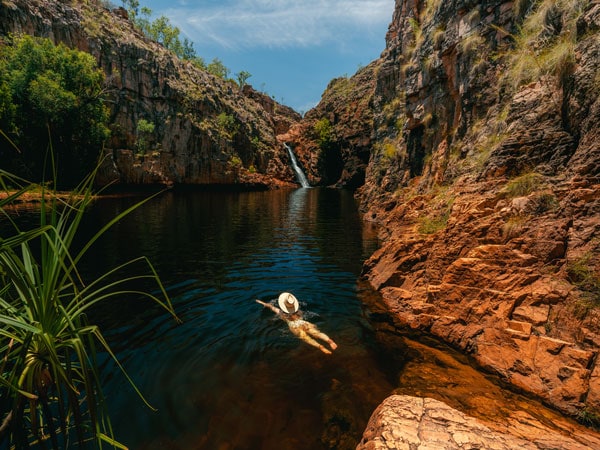
Maguk is a spectacular swimming hole fed by a waterfall. (Image: Tourism NT/@helloemilie)
Kakadu National Park is just under one-third the size of Tasmania. Some ‘do’ Kakadu in a day trip from Darwin; others spend two weeks here and still don’t see as much as they’d like. We reckon any length of time from three days onwards will help you feel like you’ve ‘done’ the park properly.
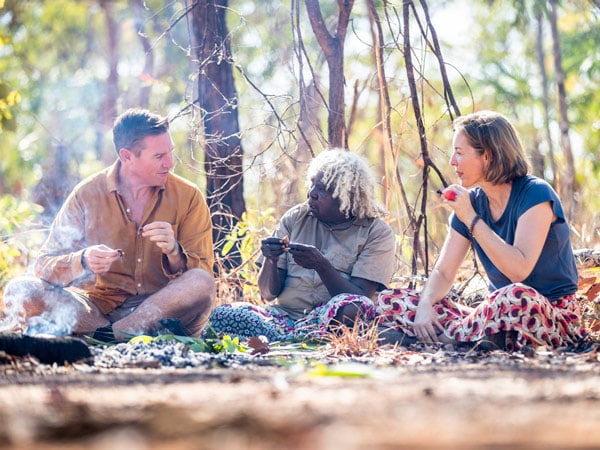
Animal Tracks Safari offers unforgettable experiences in the Kakadu wilderness. (Image: Tourism NT/Helen Orr)
Although the year can be roughly divided into two seasons, the dry (May–October) and the wet (November–April), the six seasons, used by Kakadu’s Indigenous people for millennia, will give you a much better idea of Kakadu’s weather and seasonal changes.

Hike up to the Nawurlandja Lookout before sunrise. (Image: Tourism NT/Shaana McNaught)
January to March – 24–34 degrees Celsius
Expect blue skies each morning, late afternoon thunderstorms and high humidity levels when waterfalls thunder, greenery explodes and a third of Kakadu National Park becomes floodplains.
You can still cruise, fly and drive to many of the park’s attractions; special wet seasons cruises operate at this time of year, too.
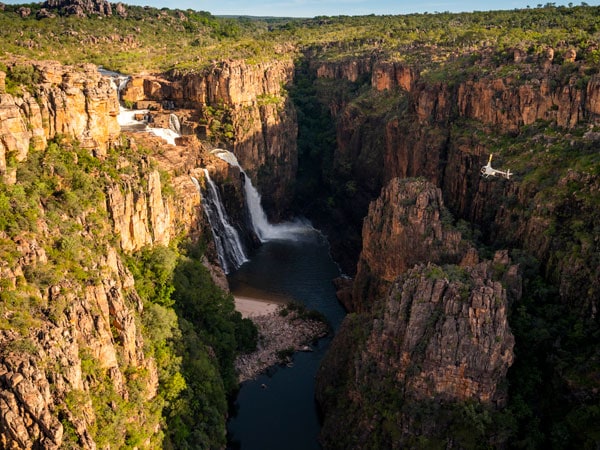
Hop on a scenic flight over Twin Falls, Kakadu National Park. (Image: Tourism NT)
April – 23–34 degrees Celsius
There are windy ‘knock-em’-down’ storms that flatten the speargrass in this time. Landscapes remain lush while receding waters – also known as the ‘run-off’ – cause fish to congregate in certain areas, making this a fantastic time of year to join one of Kakadu’s fishing tours.

Journey through Kakadu’s wetlands on a Yellow Water Cruise. (Image: Tourism NT/Tourism Australia)
May to mid-June – 21–33 degrees Celsius
Most visitors prefer Kakadu’s weather during Yekke. A lovely time to visit, when storms have finished, and wetlands are carpeted with water lilies (make sure you take a cruise). Cooler breezes bring morning mists and respite from the humidity.
Previously flooded roads open up, offering access to different areas of the park.

Soak up misty mornings in Kakadu. (Image: Tourism NT/Sean Scott)
Mid-June to mid-August – 17–32 degrees Celsius
As waterways and floodplains have dried up, some wet season cruises are unavailable, but more open roads mean more access via car instead. Meanwhile, magpie geese, fat and heavy from weeks of feasting, flock to billabongs, resulting in fantastic birdwatching.

Traverse the roads in Kakadu National Park. (Image: Tourism NT/Shaana McNaught)
Mid-August to mid-October – 23–37 degrees Celsius
Heat returns and clouds start to gather, but humidity keeps its distance. Billabongs remain crowded with Kakadu’s iconic birds (including magpie geese), ensuring great birdwatching; the majority of the Kakadu National Park remains accessible by road.

Get up close encounters with Kakadu’s iconic birds like Magpie Geese. (Image: Tourism Australia/Bamurru Plains)
October to December – 24–37 degrees Celsius
Kunumeleng can last from a few weeks to several months, with dazzling lightning shows that hint at storms to come. Almost all roads are still accessible at this time of year but watch for early rains.

Crocodiles move freely in Kakadu. (Image: Tourism NT/Sean Scott)
Although the park is sparsely populated, there is still a diverse range of accommodation options that range from luxury lodges to glamping and wild bush camping.

Set up camp on the bushland with Offroad Dreaming. (Image: Tourism NT/Tourism Australia)
Most of Kakadu’s accommodation options are clustered around Jabiru, the only township in the Kakadu National Park. There’s an abundance of campsites located in the heart of the park, as well as some lodges with powered sites, restaurants and amenities onsite.
Read our comprehensive guide on accommodation in Kakadu National Park for all your accommodation needs.

Camping in Kakadu is best to unplug and unwind. (Image: Tourism NT/Tourism Australia)
With an abundance of cultural sites and walking trails in Kakadu National Park, it’s certainly possible to visit the park independently. However, it’s a great idea to seek out Indigenous-owned businesses and guides, as Aboriginal people hold the stories and culture tied to the landscape and have done so for 65,000 years.

Admire the outstanding rock art at Ubirr. (Image: Tourism NT/Helen Orr)
Whether you’re getting off the beaten track on a 4WD tour with a local or viewing rock art with an Indigenous guide, taking a tour in Kakadu can deeply enrich your knowledge. We’ve compiled a comprehensive guide on tours in Kakadu, so you can get a feel for what’s available.
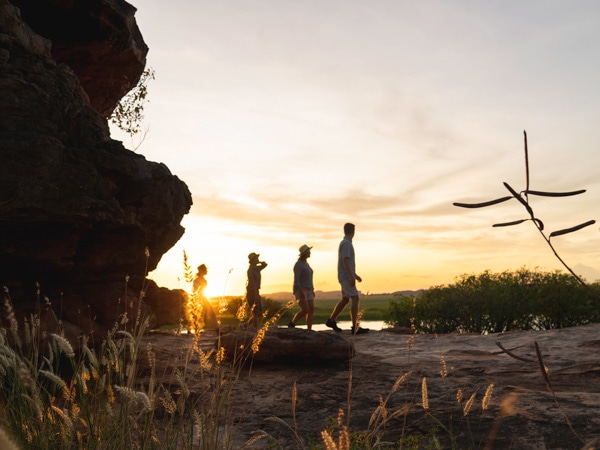
Sign up for Kakadu Cultural Tours and immerse in the wilderness. (Image: Tourism NT/Tourism Australia)
LEAVE YOUR COMMENT